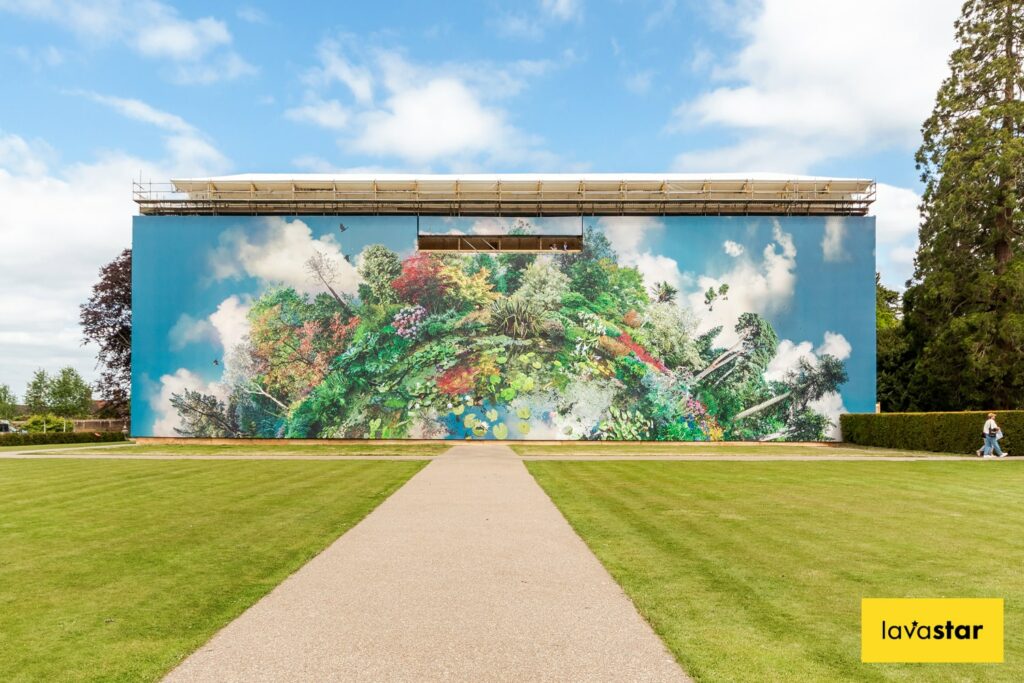The low-down on the high-up world of large printed building banners
One of the first encounters many people in the UK will have had with large printed building banners (also referred to as building wraps) will have been the Trompe L’Oeil wrap used on the pediment of the British Museum as it was renovated. This was followed by another huge renovation project a couple of years later, that of The Elizabeth Tower – formerly St Stephen’s Tower and more commonly known by the name of its largest bell, Big Ben – which used the same style of building banner to preserve the appearance of the famous facade during the project.
The Trompe L’Oeil wrap is not the only variety of large printed building banner – though it tends to be used, as in the above cases, for renovations of buildings with significant historic importance – but high concept wraps have increased in popularity over the last couple of decades as building owners seek to reduce the visual impact of large scale renovation or construction work.

What is a large printed building banner?
Also known as building wraps or scaffolding wraps, a large printed building banner is a part decorative, part functional installation that aims, as stated above, to disguise large-scale refurbishment or construction work – all while serving the same function as the commonly used polythene covers or debris netting of the past, as a method of dust mitigation and weather proofing.
While the first use of Trompe L’Oeil (literally translated as ‘trick of the eye’) in architecture actually dates back to the Roman Empire, where artists would create realistic scenes of the sky on ceilings, or of the outdoors on interior walls. However, it was a technique lost to the mists of time following the fall of Rome, and was not in common use again until the Renaissance era – when it was employed to create realistic illusions at the palaces of wealthy nobles.
The use of printed building banners as they are now commonly deployed would need to wait until the late 20th Century, however, when technology began to facilitate the creation of high quality graphics at scale – and as the technology has continued to advance, large scale building wraps have become increasingly popular.
Why use large printed building banners?
All large scale works have used some kind of covering (debris netting, for example) for dust mitigation and weather proofing for several decades, and printed building banners serve all the same functional purposes. However, the modern high concept designs serve additional decorative functions – they serve to diminish the negative impact of building works on local communities, they demonstrate a commitment to minimising disruption, they offer an opportunity to build excitement or intrigue around a project, and can serve as a way to preserve or enhance the appearance of a building while work is underway.
In addition to their use in construction, however, large printed banners are used for a range of purposes – from refreshing outdated building facades to marketing and most things in between.
How are large printed building banners installed?
The method of installation will vary depending on the size of a project, but are generally attached with weatherproof fixings directly to scaffolding, with overlaps between banners then connecting to one another with either ties or heavy duty velcro, depending on the project’s requirements. Panels are either elevated into position using mobile elevating platforms (where access permits) or using ropes when such machinery would cause undue disruption.
The order of installation varies from project to project, depending on building shape, protrusions and area of coverage, with comprehensive planning required (we advise that this is done prior to the assembly of scaffolding) to ensure the best possible join between panels. You can read more about the types of installation Lavastar offers here.
Varieties of building banners
Although we’ve focused on a few specific uses for here, you will have doubtless seen building wraps in a host of other situations. These include (but are in no way limited to – it’s a versatile product):
- Advertisement: – thanks to modern printing techniques and materials, newer glass fronted hotels and office buildings are increasingly using their own buildings as media space for out of home (OOH) advertising. With people inside still able to see through windows and no loss of sunlight inside, such wrap types make exceptional advertising spaces.
- Event promotion: – commonly used by city councils or central governments, event promotion wraps are a way to transform a building into a celebration of an upcoming sporting or cultural event, and have been used by cities all over the world to promote Olympic and Commonwealth Games and large cultural festivals.
- Building refreshes: – used to refresh a tired or outdated facade – for example, on the Lime Street facing facade of St Johns Shopping Centre in Liverpool, building wraps can convert lacklustre mid-century architectural designs into vibrant, modern frontages that better reflect the developments internally.

Lavastar’s Large Printed Building Banners
Lavastar’s comprehensive, end-to-end service, and in-house teams of skilled designers, manufacturers, and installers have made us one of the most trusted providers of large printed building banners for businesses in London and the UK.
We always strive to partner with our customers to deliver a product that everyone can be proud of. From concept to print and all the way to expert installation at scale, we make sure that our large printed building banners provide more than just a pretty picture, they help to build brands and communities. We’re a team you can trust.
For more information about our building wraps, reach out to our team at 020 3281 7395 or info@lavastar.co.uk.






